
Compact Fluorescent Light (CFL) F.A.Q.'s
If you have questions about the benefits of Compact Fluorescent Light bulbs, how to use them, and how to dispose of CFL light bulbs, check out our FAQs below. We also have helpful tips on how to choose the right CFL bulb and how ENERGY STAR rated CFLs can save you money. Use the links below to jump to the section that interests you.
Benefits of CFLs
What does CFL stand for?
CFL stands for Compact Fluorescent Lamp, a small fluorescent light bulb that uses 75% less energy than a traditional incandescent bulb and can be screwed into a regular light socket. Don't let the fact that it is fluorescent turn you off! ENERGY STAR qualified CFLs must pass extensive testing to ensure they produce only the highest quality light.
Why should people use CFLs?
Switching from traditional light bulbs to CFLs is an effective, accessible change anyone can make right now to reduce energy use at your business or at home. Lighting accounts for close to 20 percent of the average home's electric bill. Changing to CFLs costs little upfront and provides a quick return on your investment. Using CFLs is also a way to prevent the greenhouse gas emissions that contribute to global climate change.
If every home in America replaced just one incandescent light bulb with an ENERGY STAR qualified CFL, it would save enough energy to light more than 3 million homes and prevent greenhouse gas emissions equivalent to those of more than 800,000 cars annually.
What is the difference between the coil design and the CFLs that resemble a traditional lightbulb?
There are a handful of differences between the coil or "spiral" CFLs and the CFLs that resemble a traditional lightbulb (A-line shape). The first difference is the amount of light each will produce. Most times, a CFL that looks like an incandescent light bulb is really the "coil" shaped CFL with a plastic or glass cover.
This cover will slightly reduce the amount of light that is produced. If you compared a 14W bare spiral CFL and a 14W "incandescent" shaped CFL, the bare product will provide more light for the same wattage. Also, bare CFLs usually have longer lifetimes than covered products.
Second, most bare spiral CFL products will perform like incandescent light bulbs - they will turn on instantly and provide full brightness. Covered CFLs may take slightly longer to reach full brightness.
The last difference is the price - covered CFLs generally cost slightly more than bare spiral because of the additional materials required to manufacture the products.
What are "long life" bulbs?
While a "long life" bulb does last longer than a standard incandescent bulb, it still uses a lot of energy and it doesn't last as long as a Compact Fluorescent Light (CFL). A long life 60-watt incandescent bulb usually lasts for 2,000 hours, but an equivalent 13-watt CFL will last 6,000 hours or more, and use 75% less energy. CFLs help you save money in utility costs and you won't have to buy and change bulbs as often.
What are some common CFL bulb wattages and lumen ratings?
Compact fluorescent bulb wattage ranges from 11 to 42 watts. They use 75% less energy than the equivalent incandescent bulbs, which range between 40 and 150 watts. Some of the most common CFL wattage equivalents are 13 watt CFL (equivalent to 60 watt incandescent) and 23 watt CFL (equivalent to 100 watt incandescent).
At the same time, compact fluorescent lumens fall into the same range as their incandescent equivalents, between about 490 to 2,600 lumens. A 13 watt CFL bulb provides approximately 900 lumens. That means you can get the same amount of light while using much less energy.
Back to TopDifferent Types of Light Bulbs
When choosing the right bulbs for your lights, it is important to consider a light bulb's energy efficiency, how much it will light a certain area, price level, and life expectancy.
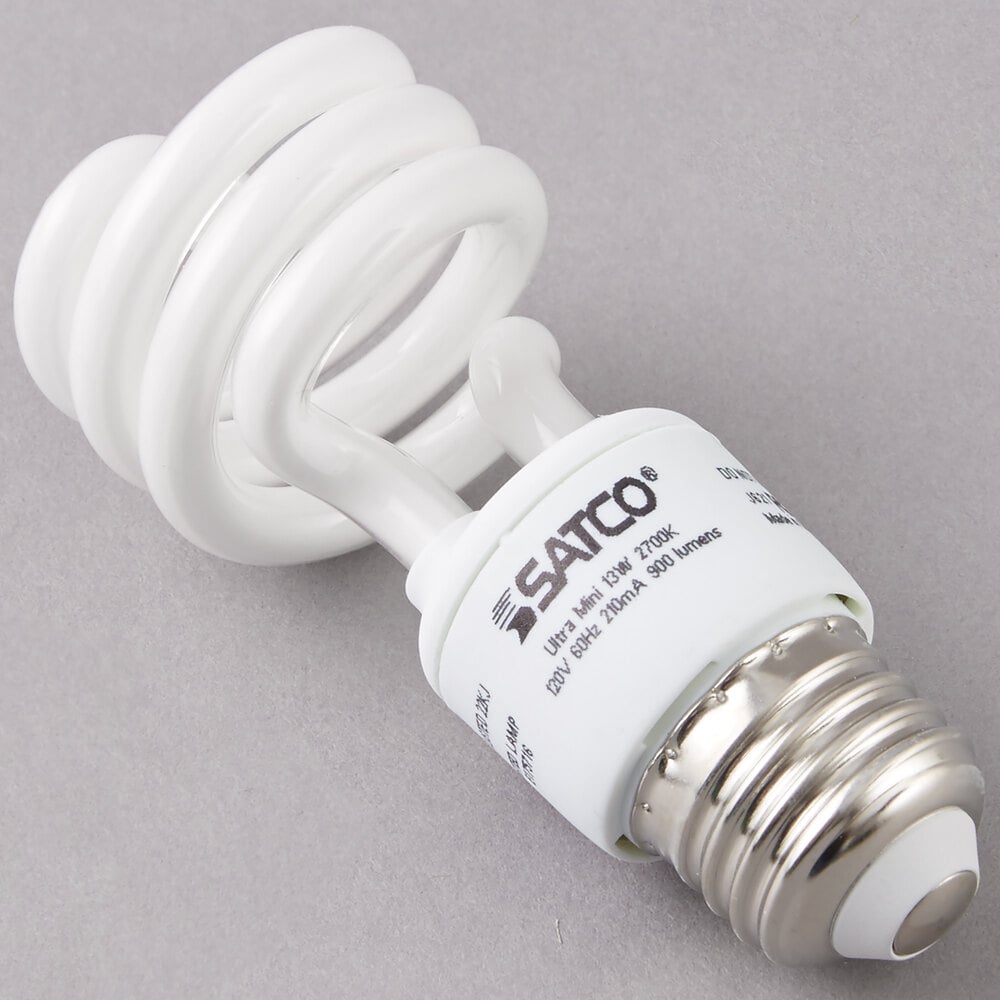
Compact Fluorescent Bulbs
CFL light bulbs consume only a fraction of the electricity needed to power an incandescent bulb and can last many times longer. CFL bulbs run quietly and offer more options than older-style fluorescent bulbs.
Price Level: $$
Life: 7-9 years
Temperature: Warm white, bright white, daylight
Wattages Available: 3-120 watts
Dimmable?: No
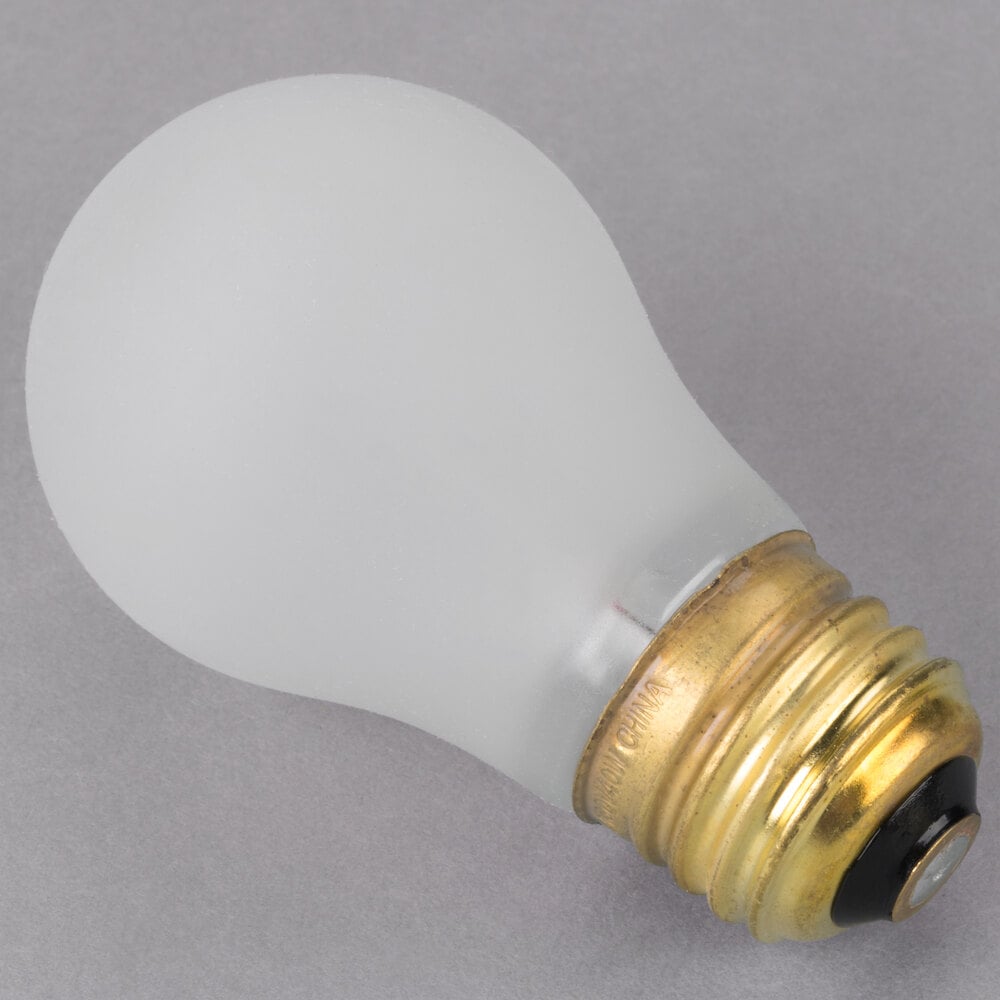
Incandescent Bulbs
Incandescent light bulbs use more electricity than fluorescent or LED bulbs but are the most common and least expensive options. Convenient and cost-effective, these bulbs are a good choice for many applications.
Price Level: $
Life: 1-2 years
Temperature: Warm white
Wattages Available: 5-500 watts
Dimmable?: Yes
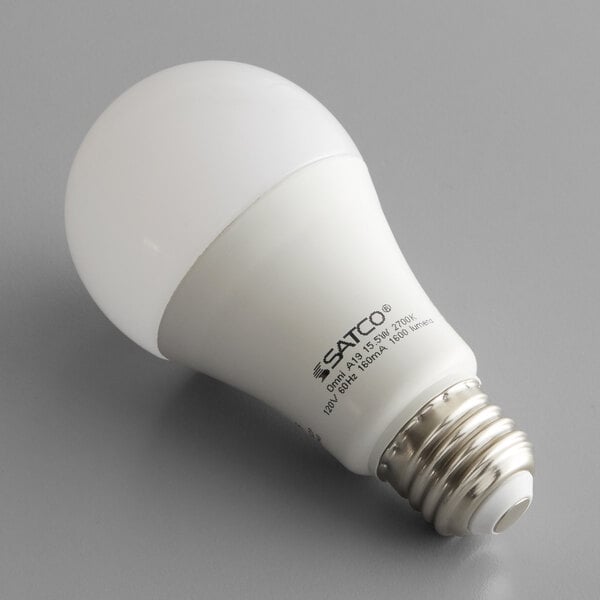
LED Bulbs
LED light bulbs use a fraction of the electricity to provide more light compared to other bulb types. While LED (light-emitting diode) bulbs are bright, they provide directional light and may not work for large spaces.
Price Level: $$$
Life: 9-22 years
Temperature: Warm white, bright white, daylight
Wattages Available: 2.5-16 watts
Dimmable?: Yes
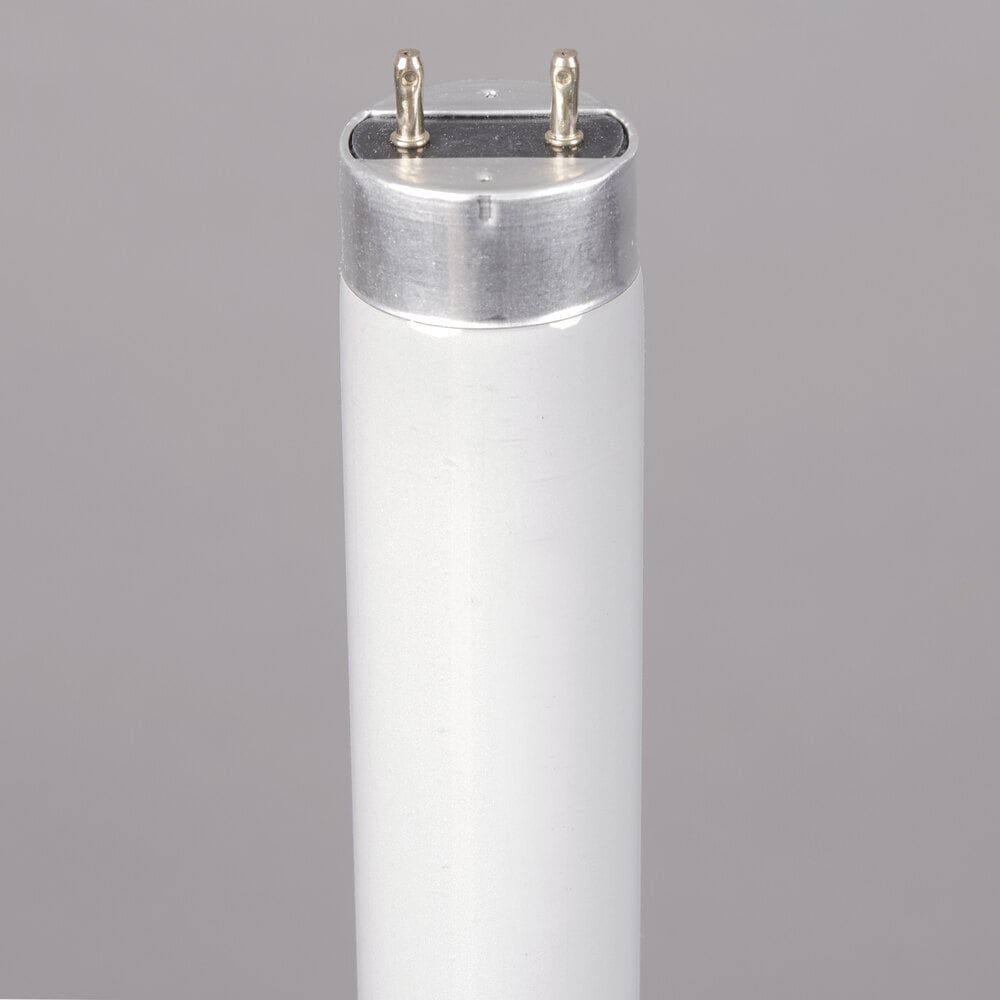
Fluorescent Bulbs
Fluorescent light bulbs are great for lighting large spaces. They produce more light than incandescent bulbs and last longer. They may take a few seconds to turn on and reach full brightness, and should not be turned on and off frequently.
Price Level: $$
Life: 2-7 years
Temperature: Warm white, bright white, daylight
Wattages Available: 4-100 watts
Dimmable?: No
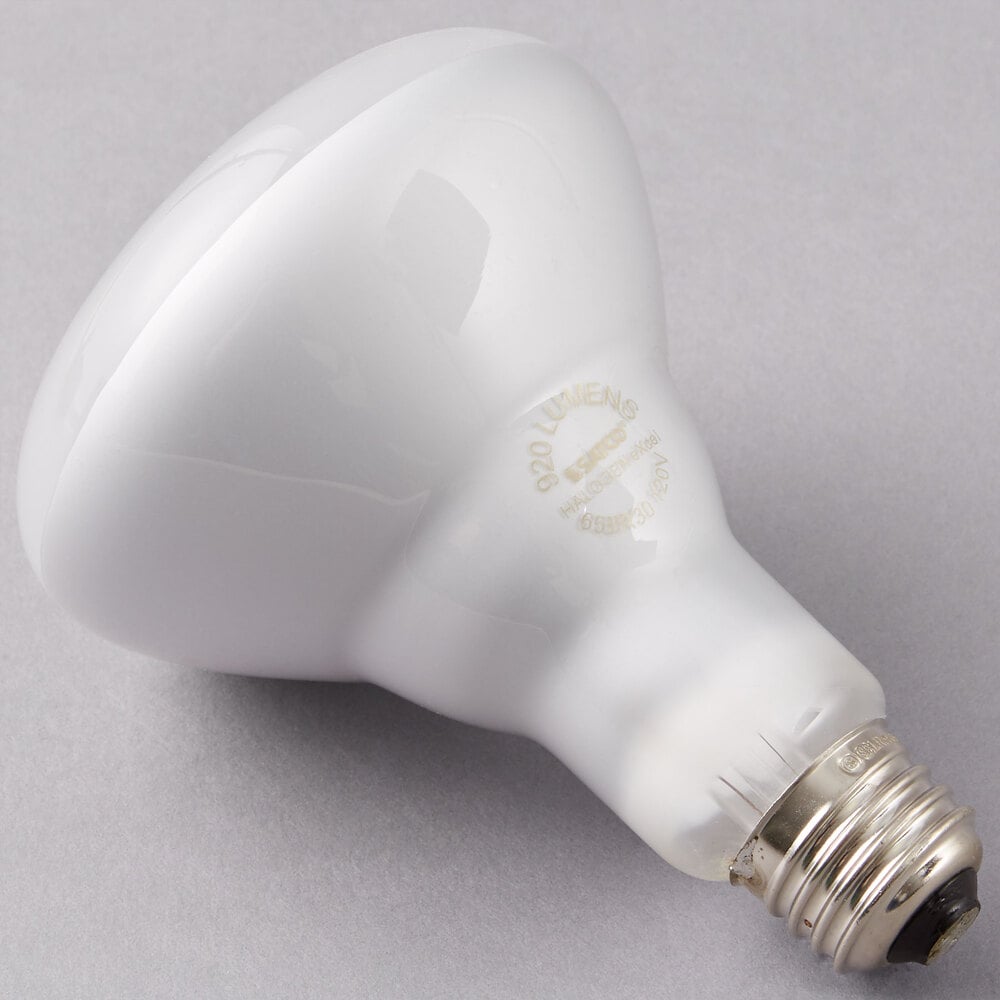
Halogen Bulbs
Halogen light bulbs are similar to incandescent light bulbs but are a little more energy efficient. When changing halogen bulbs, avoid direct skin contact as the oils from hands can cause these bulbs to break when turned on.
Price Level: $$
Life: 1-2 years
Temperature: Warm white, bright white
Wattages Available: 5-500 watts
Dimmable?: Yes
CFL Bulb Energy Savings Calculator
Annual Savings switching to fluorescents: $51
Choosing the Right CFL
How can I find the right colored CFL light bulbs?
Choosing the right lighting for your restaurant or business enhances the ambiance. In the same way incandescent bulbs are labeled soft white, cool white, or bright white, you will find CFLs labeled soft white, cool white, or daylight (similar to bright white). When selecting a new CFL, it's a good idea to use the same color type as the incandescent you are replacing. Another way to do this is to look for the scientific color designation, also known as correlated color temperature (CCT). You will see this represented on the packaging as 2700K, 3000K, 5100K, etc.
Lower CCT numbers mean the light will be warmer white (yellow), while higher numbers mean it will be cooler light (blue). Matching the number of your former incandescent bulb with your new CFL will give you consistent color. The majority of CFLs available on the market offer soft or warm white light (2700K-3000K), which is comparable to an incandescent bulb. When changing out multiple bulbs in one room, select CFLs with the same color and the same manufacturer to help ensure more consistent light color.
I want to replace my 60-watt incandescent light bulb. How do I select the best CFL?
Finding a CFL that will put out the same amount of light as your current incandescent bulb is easy. Manufacturers include product equivalency information on the packaging to help consumers choose a bulb that produces enough light. For example, if you are looking for a light bulb to replace your 60-watt incandescent, look for words like "Soft White 60", or "60 Watt Replacement" on the packaging.
Back to TopCFL Usage
Can Compact Fluorescent Lights (CFLs) be used in recessed cans, outdoor lights, or track lighting?
Yes! Always read the packaging of the CFL to be sure of its proper application, but there are a wide variety of ENERGY STAR qualified CFLs that are designed for use in most fixtures in your home or business. Product types include:
- Incandescent shape (or A-shaped) and Globes, both are good in fixtures where the bulb is exposed or in fixtures with clamp lamp shades
- Reflectors are intended for non-dimmable track lighting and recessed cans, and some weather-protected outdoor spot lights
- Candle shapes can be used in some porch lights, in wall sconces, and in some chandeliers
- Spirals and mini-spirals are getting smaller in size and can be used in almost any fixture, especially table and floor lamps with harped shades
There are a few qualified 3-way and dimming CFL models that can be used for 3-way fixtures or in dimmable recessed cans or CFL track lighting.
My light fixture can is for a 75 watt bulb, if I use a CFL can I use the equivalent of 100 watts?
The watt rating on the fixture is a description of how much electricity the internal wiring of the fixture can accept safely. A watt is a measure of power consumption. Since the light fixture can accept up to 75 watts of power, you can use any light bulb with a rated wattage of 75 or less.
While you can use a 75-watt equivalent CFL, if you want more light in this fixture you could also use a CFL that produces as much light as a 100-watt incandescent. For instance, a 100-watt equivalent CFL will typically use between 23 and 30 watts less than the 75-watt rating of the fixture. That's the great thing about CFLs - you get more light for less power! This logic applies whether you are asking can I use an incandescent bulb in a CFL fixture, or the other way around.
What is a watt? What is a lumen?
A watt is a measure of power consumption and is the common method by which incandescent light bulbs are identified. For example, you'll find bulbs labeled as 60-watt, 75-watt, or 100-watt. When purchasing a light bulb, try looking at lumens instead.
Lumens are the measure of light output. When you purchase a 60-watt incandescent bulb, you are getting about 800 lumens. By selecting 13 watt compact fluorescent bulbs instead, you can still get 800 lumens each, but it requires much less power.
Check out our table below to see how CFLs compare to incandescent bulbs with the same lumen output:
Minimum Light Output (Lumens) | Energy Use for Incandescent Light Bulbs (Watts) | Energy Use for common ENERGY STAR qualified CFLs (Watts) |
|---|---|---|
250 | 25 | 4 to 9 |
450 | 40 | 9 to 13 |
800 | 60 | 13 to 15 |
1,100 | 75 | 18 to 25 |
1,600 | 100 | 23 to 30 |
2,000 | 125 | 28 to 40 |
2,600 | 150 | 30 to 52 |
I've noticed some CFLs need a few minutes to warm up, or reach full brightness...
By choosing an ENERGY STAR qualified CFL, you are assured that it will turn on in less than a second and reach at least 80% of full light output within 3 minutes. If the CFL doesn't have ENERGY STAR certification, both start time and warm up time could be much longer.
Some spiral and mini-spiral (mini fluorescent light) products incorporate "instant-on" technology and display this feature prominently on the product packaging. Some covered or reflector CFLs actually do take longer to warm-up, but the trade off is that they last longer than regular CFLs.
ENERGY STAR qualified CFL products that are covered (like incandescent shaped, reflectors, globes, or candles) have a higher operating temperature so they require a compound called amalgam to perform properly. This compound actually increases the bulb life and the light output! The one trade off is that these CFLs cannot offer "instant full brightness". The CFL will turn on, but it may take up to three minutes to warm up and reach full light output..
Can I turn my Compact Fluorescent Lights on and off frequently?
Turning a CFL on and off frequently can shorten its life. To take full advantage of the energy savings and long life of CFLs, it's best to use them in the light fixtures you use the most. Lights that stay on for at least 15 minutes at a time are best. Good locations include outdoor light fixtures, or indoor fixtures in your lobby, dining room, kitchen, and restrooms. This is not to say you should leave your lights on all day if you use CFLs. It's still a good habit to turn the lights off when you leave the room for an extended period of time.
Does extreme cold or humidity affect CFLs?
Extreme temperatures can affect CFLs. Some CFLs can be used outside in temperatures down to -10 degrees Fahrenheit and up to 120 degrees Fahrenheit, though when it is very cold they may take longer to reach full brightness. If you are looking for an outdoor fluorescent light fixture that is weatherproof and can be used outside, check for "weatherproof" on the label before installing it in your outdoor spot light.
Back to TopEnergy Star Info
Why choose ENERGY STAR qualified CFLs over a non-qualified CFL?
ENERGY STAR qualified CFLs are different than other CFLs on the market because they have been tested to meet stringent performance criteria established by the U.S. Department of Energy and the U.S. Environmental Protection Agency. The criteria ensure that all CFLs earning the ENERGY STAR certification meet minimum lifetime and efficacy requirements and are within maximum allowed product start and warm-up times. Manufacturers are also required to label the product if the light output is different than that of a soft white incandescent. If you choose a CFL that is not ENERGY STAR qualified, you might not get the performance you were looking for.
Will ENERGY STAR qualified CFLs fit into my existing fixtures?
It's possible to find ENERGY STAR qualified CFL incandescent equivalents that can replace regular incandescent bulbs in almost any fixture. They come in a wide variety of sizes and shapes, including globe lamps for your bathroom vanity, chandelier bulbs, lamps for recessed downlights, or larger and more compact standard light bulbs.
Check the packaging of the CFL to ensure that it may be used in an entirely enclosed fixture. Additionally, some ENERGY STAR qualified CFLs are specifically designed to provide dimming and 3-way functionality. These options will be identified on the products' packaging.
How is an ENERGY STAR qualified CFL different from the incandescent light bulbs I grew up with?
Incandescent light bulbs work by heating a tungsten filament, or wire, until it glows. This is what produces the light you see. Unfortunately, 90% of the energy used to generate that light is wasted as heat, making incandescent bulbs a very inefficient way to light your business. ENERGY STAR qualified CFLs, on the other hand, create a chemical reaction among gases located inside the glass tube, causing phosphors to illuminate. This is a much more efficient way of producing light and means CFLs produce far less heat.
What's the difference between ENERGY STAR qualified fixtures and standard fixtures?
Most ENERGY STAR qualified fixtures come with pin-based compact fluorescent lamps that are tested to last at least 10,000 hours (about 7 years, on average), versus standard screw-in bulbs which last about 1,000 hours or up to 1 year.
Some ENERGY STAR qualified outdoor fixtures will accept an incandescent light bulb because they save energy through a motion sensor. Qualified fixtures come in hundreds of popular styles, including table, floor and desk lamps and hard-wired styles for ceilings, walls, and outdoors.
Back to Top
CFL Bulb Disposal
Do CFLs contain mercury?
CFLs contain an average of 4 milligrams of mercury sealed within the glass tubing. This is roughly equivalent to the amount that would cover the tip of a ball-point pen. No mercury is released when the bulbs are intact or in use. By comparison, older thermometers contain about 500 milligrams of mercury, and it would take 125 CFLs to equal that amount. In the last several years, many manufacturers have dropped the mercury content in their CFLs to 1 milligram.
How do I dispose of a CFL bulb?
Because CFLs contain a small amount of mercury, the EPA recommends that consumers take advantage of local recycling options for used fluorescent light fixtures where available. Consumers can contact their local municipal solid waste agency directly, or visit the site lamprecycle.org to identify local recycling options. Some recycling services also help you ship old CFL bulbs to the proper facility for disposal. If your state permits you to put used or broken CFLs in the garbage, seal the CFL in two plastic bags and put into the outside trash. CFLs should not be disposed of in an incinerator.
You can also check with your local municipalities to find the closest hazardous waste collection site. If you transport old CFL bulbs yourself, be careful to avoid breaking them.
What precautions should I take when using CFLs?
CFLs are made of glass and can break if dropped or roughly handled. Be careful when removing the bulb from its packaging, installing it, or replacing it. Always screw and unscrew the lamp by its base (not the glass), and never forcefully twist the CFL into a light socket. Because CFLs contain a small amount of mercury, follow proper clean-up recommendations if a CFL breaks in your home.
How should I clean up a broken compact fluorescent light bulb (CFL)?
Because CFLs contain a small amount of mercury, EPA recommends the following clean-up and disposal guidelines:
- Open a window and have people and animals leave the room for at least 15 minutes.
- Turn off any air heating or air conditioning systems.
- Remove all materials you can without using a vacuum cleaner.
- Wear disposable rubber gloves, if available (do not use your bare hands).
- Carefully scoop up the fragments and powder with stiff paper or cardboard.
- Wipe the area clean with a damp paper towel or disposable wet wipe.
- Sticky tape (such as duct tape) can be used to pick up small pieces and powder.
- Place all cleanup materials in a plastic bag and seal it.
- If your state permits you to put used or broken CFLs in the garbage, seal the CFL in two plastic bags and put into the outside trash (if no other disposal or recycling options are available).
- Wash your hands after disposing of the bag.
- The first time you vacuum the area where the bulb was broken, remove the vacuum bag once done cleaning the area (or empty and wipe the canister) and put the bag and/or vacuum debris, as well as the cleaning materials, in two sealed plastic bags in the outdoor trash or protected outdoor location for normal disposal.
Back to Top
Related Resources

Top 10 Energy Conservation Tips for Restaurants
Reducing your restaurant's overall energy consumption not only lowers your utility costs , it's also better for the environment. Many food service professionals have been adopting energy conservation methods for the past decade and have drastically cut their energy use and expenses. Here, we've outlined energy conservation tips that will reduce your water and electricity use. 10 Energy Conservation Methods It can be easier than you think to reduce energy consumption in your kitchen with our energy-saving methods! Here are our top 10 tips for conserving energy in your business. Click any of the links below to read more about our energy-conservation tips: Energy Efficient Equipment Equipment Maintenance Reduce Water Consumption Efficient Ligh

Biodegradable, Compostable, & Zero Waste Explained
One of the fastest-growing foodservice trends is switching from traditional disposables and foodservice products to eco-friendly options. When searching for eco-friendly products for your restaurant, you may come across the terms "biodegradable", "degradable", and "compostable". We explain the differences between biodegradable, degradable, and compostable products, and how your restaurant can go zero waste with eco-friendly disposables. Biodegradable, Compostable, and Degradable: What's the Difference? Biodegradable, compostable, and degradable products are made from different materials and deteriorate under distinct circumstances. We break down what each material is to help you make an informed decision when buying green disposable dinnerw
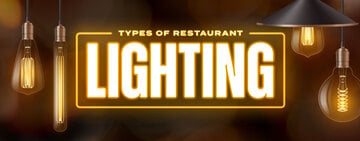
Restaurant Lighting
Lighting plays a crucial role in the success of any restaurant. It not only creates a welcoming and comfortable atmosphere for customers but also enhances the overall dining experience. The right lighting can make food and beverages appear more appetizing, highlight the restaurant's unique features and designs , and set the desired mood. Discover below the most important aspects operators need to consider when deciding restaurant lighting, and how they can utilize it to affect the moods and experiences patrons have at their restaurant. Shop All Restaurant Lighting Use these links to learn more about the different aspects of restaurant lighting: Restaurant Lighting Ideas Restaurant Lighting Design Types of Restaurant Lighting Smart Restauran
- Topics 1357
- Industrial 55
- Troubleshooting Guides 21
- Restaurant Management 128
- Bar Management 56
- Catering Tips 36
- Bakery Management 42
- Food Trucks & Concessions 49
- Advertising & Marketing 37
- Eco-Friendly Tips 11
- Facility Layout & Design 42
- Coffee Shop Tips 28
- Installation & Maintenance 51
- Janitorial & Pest Control 30
- Safety & Sanitation 88
- Startup Tips 104
- Menu Design 10
- Kitchen & Cooking Tips 84
- Hospitality Management 24
- Pizza & Sandwich Shop Tips 36
- Smallwares 37
- Food Prep 89
- Tabletop Items 17
- Disposables 22
- Calculators & Tools 6
- Consumables 52
- Warewashing & Laundry 19
- Cooking Equipment 91
- Food Storage & Refrigeration 51
- Beverage Equipment 35
- Office Supplies 6
- Resource Type
- In-Depth Articles273
- Buying Guides298
- How-Tos95
- Product Reviews78


